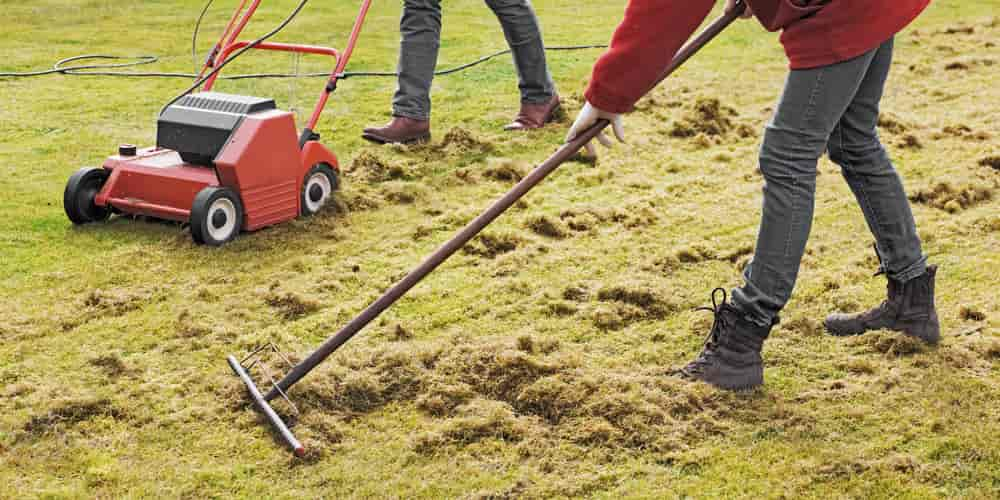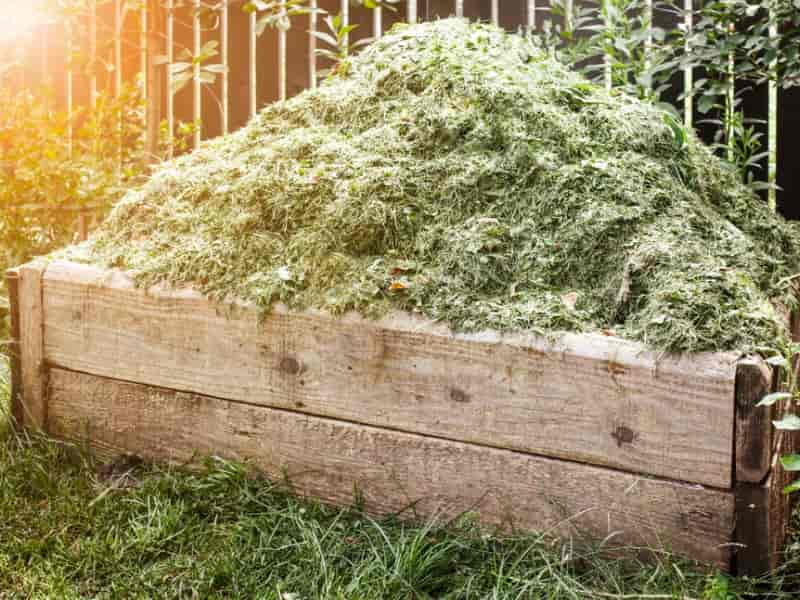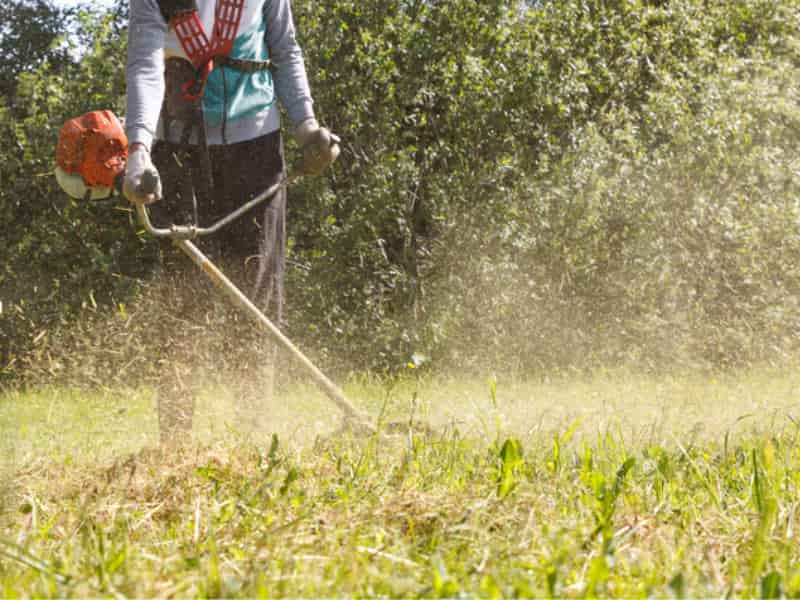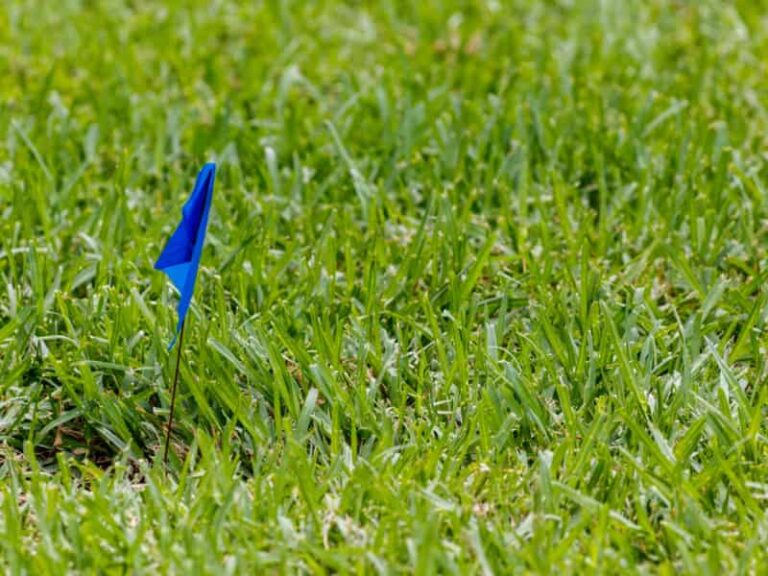How to Remove Dead Grass from Lawn after Roundup
Roundup is a Glyphosates-based herbicide that works as a non-selective plant killer to remove weeds, shrubs, grass, and other plant species by inhibiting enzyme action. While it is effective, it kills off the grass and leaves brown unsightly patches in huge areas where the grass was lush. The dead foliage inhibits new growth and makes your outdoor space look dead and drab. Removing the dead grass is the first step to reclaiming your lawn after Roundup.
So how do you clear the dead grass to prepare the lawn for a new look?
The most effective methods to remove dead grass after Roundup call for machines. These include
- Dethatching and mowing
- Using a power rake
- String trimming
- Sod cutting
Alternatively, you can map out small affected areas and manually shovel the dead grass from the lawn.
Use these detailed methods to clear the brown patches of dead grass after exposure to Roundup.
Contents
How to Remove Dead Grass From your Lawn
There are numerous options available when removing dead grass. You can pick up, dig and pick the dead organic matter from a small patch of soil. Although this is an effective method, it is slow and tiring. It is strenuous work that could take less time and effort if you mechanized the process.
1. Mowing and Dethatching to Remove Dead Grass
Dethatching is an effective method of eradicating dead grass from your lawn that involves using a dethatcher and lawnmower to remove dead leaves from your turf’s surface
The best time to dethatch is before the peak grass growing season. For warm weather grass, dethatch during late spring. However, you can dethatch cool-season grass at the onset of fall.

Here’s how to properly dethatch dead foliage from your lawn.
- Water your grass about 24 hours before you begin dethatching. The idea is to create a moist surface to minimize leaf damage during dethatching.
- Mow your lawn to a level slightly less than the average grass height. Mowing at a lower height allows you to cut more foliage and expose young foliage to the sun.
- Use a rake to remove dead foliage from your lawn. Raking from different directions removes grass from different angles. You’ll get a cleaner surface when you remove the grass from different angles.
- Collect the dead grass in heaps. It is easier to remove the heaps of grass if you collect them in small mounds. Dispose of the heaps in garbage bags. You can set the heaps of dead grass in a separate corner of the yard and allow it to decompose.
Dethatching can cause sections of your turf to become bare. Spread your seeds and sods to affected surfaces to promote an even surface as the grass regenerates.
2. Using Power Tools To Remove Dead Grass
Power tools are faster and more efficient choices for removing dead grass from your lawn. However, the ideal tool depends on the turf’s size.
You can use a regular rake for small sections. Large and more extensive grass surfaces such as golf courses and football fields might require a power rake, sod cutter, or commercial dethatcher.
A power rake is a motor-powered tool that has multiple nylon/metal tooth extensions on the outer edges of each blade. The attachments remove dead grass from your lawn surface and keep it neat and healthy. An ideal power rake time depends heavily on the grass type.
Turfgrass that grows in cool weather is best raked in the early fall, while turfgrass that grows in warm climates is best raked in late spring or early summer to allow for sufficient growing time and recovery.
Diving or tilling may be the best method for removing an old grass variety if extensive damage occurs. Digging about 2-4 inches into the soil surface is crucial to completely eradicate rhizomes, roots, and other grass components that can propagate in the future.
Follow the ideal steps when preparing a new lawn growing surface in such a case.
3. Smothering and Composting
Composting is an eco-friendly solution to dead grass removal. For a warm-season grass variety, it’s best to start working on the lawn during the fall when the grass becomes dormant. It’s easy to collect organic compost such as leaves and grass clippings.
Use cardboard, brown paper, and other organic papers to smother the affected surface or patch. Make sure you add grass clippings, leaves, and other organic matter, and water the compost patch.

The organic matter decomposes over time and provides a surface ready for planting/sodding during spring (or after seeding). You can opt to periodically add small amounts of compost to your lawn instead of using fertilizer.
A ¼ to ½ inch spread over a dethatched surface coupled with human action, wind, and rain allows quick compost movement to the soil surface.
The compost provides mulch and essential nutrients to the soil giving your lawn a quality growing surface without relying on chemical products.
It’s best to smother grass (sheet mulching) in the fall since it will go dormant in summer. It’s important to sheet mulch when the grass is alive and growing.
4. Cutting the Grass with a String Trimmer
The first step is setting the correct height. Keep the trimmer head about 3 inches off the ground. Move the machine like a pendulum moving parallel to the ground. Maintain a steady hand while at it.

If you are trimming tall grass left by Roundup, you’ll probably get blades of grass bunched up around the trimmer. The clog will slow down your machine. As a solution, trim from the top down. It cuts the long grass into smaller pieces. Get a special grass-cutting head with 3 blades. It cuts the grass stems without clogging up the head and stalling the machine.
5. Sod Cutting to Remove Grass
Of all the grass removal methods covered, sod cutting is the most expensive. Sod cutting, however, is the most commercially applicable method if you are dealing with huge tracts of land.
Sod cutting uses a sod cutter to remove grass strips from the root with some soil attached. Since Roundup kills the grassroots, sod cutting is a great way to clean up the turf before preparing the grounds for new grass.
A manual sod cutter needs you to grab the horizontal handle and use your foot to drive the blade into the soil. You then push forward the sod cutter to remove the strip of grass.
The most affordable option is to rent a sod cutter and remove the grass after using Roundup. A gas-powered sod cutter will give you quicker results and more uniform removal.
Here is a video to remove dead grass after roundup:
Will Grass Grow Back after Roundup?
No, targeted grass will not grow back after Roundup. The chemical compound can last up to 249 days in the soil after its initial application. During this period, it kills the grass up to the root. However, you can establish new grass on the soil surface after a three-day to a one-week grace period.
The herbicide rarely harms new seeds or sods. Regular watering helps push the chemical components of the herbicide deeper in the soil and reduces the intake of the same to young growing seeds.
The Best Way to Regrow Grass After Using Roundup
You might have to reseed your grass after using a Roundup. Depending on the grass type, it typically takes about 2-10 days.
Here’s how to regrow grass after using the weed killer.
1. Prepare your lawn.
Lawn preparation is a crucial aspect of the proper reseeding activity. You can start working on the preparations about three-four days after you are confident your herbicide application has achieved its purpose.
An appropriate lawn preparation routine includes thatching, aeration, and evening out the soil. During the preparation phase, you can top dress with new soils, compost, and or additional organic compounds.
Glyphosates acidify the soil. Check the pH levels of the earth and neutralize the acidity by applying lime or other alkalizing compounds before replanting.
2. Select the best seed
It’s vital to select the best seeds for your lawn depending on your budget, preference, and prevailing environmental conditions.
Choosing the ideal seeds requires extensive research, comparisons, and careful consideration of external and internal factors. Different seeds/sods need specific growing conditions for optimum results. For example, warm-season grass responds best in regions with constant sunlight, moisture, and temperatures between 80 and 95 degrees Fahrenheit.
Planting a warm-season variety in a predominantly chillier location may affect your lawn quality and make it susceptible to drying off. Consider factors such as the effects of traffic on the grass surface, when to fertilize your seeds, and the best fertilizer to use for specific growing requirements.
3. Spread your seed
Most grass varieties have one or more grains as the primary germination agent. However, you can find others that use sods. Spread grass seeds/sod evenly after spraying herbicide.
Use a seeding machine to facilitate effective seeding. The size of your lawn determines whether to use your hands, use a small hand-pushed seeding tool, or go for a large commercial seeder.
Additionally, be sure to use a reliable spreader when seeding your lawn; many seeding machines have options that facilitate efficient spreading by enabling you to control and set the seed quantities in a given space.
4. Feed your seeds
Feeding your seeds helps provide essential nutrients to the young, germinating grass. A potential downside of adding fertilizer relates to possible environmental damage and the promotion of weed growth that can affect the quality of your lawn.
Experts recommend adding constant quantities of fertilizer during the onset of the grass’s active growing phase for 2-3 weeks based on the plant’s nutrient requirements.
Organic slow-release fertilizers are ideal when feeding growing grass. Most organic fertilizers have a considerable concentration of Nitrogen, Phosphorous, and Potassium which are essential in foliage and root development.
Take into account when to add fertilizer to your seeds. The time recommendations for feeding young plants depend heavily on the grass type, growing conditions, soil quality, etc.
5. Create and maintain a regular watering routine
Remember to water the grass regularly during reseeding. Turfgrass water requirements depend on soil type, weather conditions, and watering schedule.
Most grass species require watering about once or twice a week. Ensure that you water sections with about 1- 1.5 inches of water for optimal results.
Young grass seeds might require daily, short watering sessions before the plants spread and create an even turf. Be sure to adjust your watering schedule to align with the seasonal conditions. Alternatively, you can also opt for a thin layer of mulch or use straws to cover grass to safeguard against water loss during the hot times of the growing season.
Final Thought
Roundup remains a controversial option as far as herbicides go. However, it works against the grass. Once you are done with it, you need to revive your lawn. All it takes is a good machine, some hard work, and probably a handful of trash bags to remove the heaps of dead grass. Replanting the grass will give your lawn a fresh look.
References
National Pesticide Information Centre: When to plant after using weed killer?


